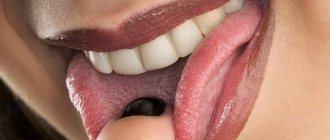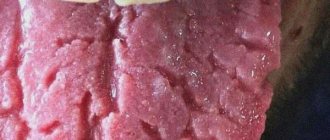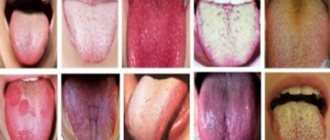September 17, 2018
The brown color in nature is very symbolic; it represents the primitive life force coming from the warm earth, the ancestor of all beginnings. But a person who chooses this shade is characterized as insecure and tired, in need of peace and relaxation, deprived of good health. But this color can appear not only in this way; for example, some may notice a brown coating on the tongue. What is this? This is undoubtedly a reason to be wary. And we’ll tell you why this needs to be done in an article prepared by the editors of the UltraSmile.ru portal.
Why does a brown coating appear on the tongue?
Fact No. 1: if you managed to quickly get rid of plaque, then there is no reason to worry
Are you finding out why your tongue has acquired a brown coating or some other color? Check whether this tint is the result of exposure to certain drinks and foods, a consequence of their frequent or recent consumption. Because if this is really the case, then there is no reason to panic. Plaque caused by drinking coffee, tea, chocolate and other products rich in tannins and brown dyes can be easily removed during a standard procedure using a regular toothbrush with toothpaste, irrigator, and rinse.
Do not forget one more important feature: a brown coating on the tongue, when excluding food dyes, diseases and pathologies, almost always indicates active smokers. At the same time, not only the tongue, but also the mucous membranes and even the teeth are painted in this unpleasant color.
If the plaque is easily washed off, then there is no reason to worry
A characteristic color also occurs in those patients who have undergone drug therapy for a long time, in particular, they have used certain groups of drugs (Faringosept, antibiotics, Malavit, medications with bismuth) - they affected the course of metabolic processes in the body and led to such an unpleasant result. This is a reason to cancel such medications. And for smokers, such a symptom is another excellent proof that it’s time to quit smoking, otherwise it’s easy to lose all your teeth as a result of periodontitis or periodontal disease.
Symptom in a child: what are the features?
Brown discharge in children usually indicates the same pathological processes as in adults. During adolescence, this symptom often appears due to sudden hormonal changes; in younger children, it may indicate the presence of worms. Among the conditions that do not pose any threat are excessive consumption of coloring foods and drinks, for example, sweet soda or desserts of the same color. In this case, the stains are again easily removed with a brush and paste. If the plaque is not completely cleaned off, it is better to immediately show the child to a pediatrician.
Fact No. 2: brown color is one of the signs of problems with internal organs
A brown coating on the tongue in adults or children has different causes, but almost always indicates that at least one of your internal organs has become infected. And, with a greater degree of probability, of all possible cases, the problem is localized in the intestines or stomach1.
Important!
The surface of the tongue is covered with microscopic papillae, which are actively involved in determining various taste sensations.
On top, the papillae are protected by a thin epithelium, which, with good immunity, constantly dies and is renewed. If disturbances are detected in the body, the epithelium becomes denser and ceases to renew itself. And given that the smallest particles of food and plaque periodically settle on it, the mucous membrane becomes the best and most convenient environment for the proliferation of bacteria. The tongue is a kind of mirror of the body. It can consider even the earliest and first signs of infectious and non-infectious diseases. It is also a muscular organ and a kind of receptor that transmits signals to other organs, in particular to the digestive tract, as a result of which metabolic processes are launched in it and enzymes are produced. If the stomach or intestines are sick, then the exact opposite reaction occurs, nerve signals go from them to our tongue. He, trying to protect himself from troubles, reacts in this way: a brown coating appears.
Stomach diseases can cause tongue problems
So, why does a brown coating appear on the tongue? Check for the presence of gastritis, ulcers, dysbacteriosis, inflammation in the intestines (the large or small intestine, duodenum may suffer), hepatitis or cholecystitis, diseases of the biliary tract.
However, a brown coating on the tongue is not always due to stomach problems. The reasons are varied: dehydration, oral candidiasis (thrush), food poisoning, violation of the regime or technique of oral hygiene procedures, dental diseases and problems, pulmonary failure, vitamin deficiency (in particular, we are talking about vitamins B3 or PP), diseases hematopoietic system (anemia or hemolysis), problems with the adrenal glands, stomatitis and even the immunodeficiency virus.
Treatment
A specialist can prescribe treatment only after identifying the cause of plaque formation. Therapy is aimed at the source of the problem, and is usually carried out in combination with diet. If plaque is caused by bad habits or food dyes, then folk remedies will help get rid of it. You can rinse your mouth with a decoction of chamomile or calendula. The course lasts no more than 5 days. If during this time the color of the tongue has returned to normal, then there is no need to worry. But if rinsing does not help, you need to urgently go to the doctor.
Fact No. 3: shade indicates different pathologies
For example, dark brown plaque indicates that the disease is in an advanced stage (liver, pancreas, gall bladder), and the body in this case needs strong therapeutic support. An adult or child who has a brown coating on the tongue may experience soreness, bitterness in the mouth, nausea and vomiting, and pain in the hypochondrium.
Brown coating on the tongue can also be light, then the cause should be sought in problems with the respiratory system or joints. Light-colored plaque is typical for asthmatics and those who suffer from pneumonia and bronchial inflammation.
“One morning I noticed in the mirror while getting ready for work that my entire tongue was brown in my mouth. To be honest, I was very scared, I tried scrubbing with a brush and even an irrigator and a special nozzle to clean it, but it didn’t help. Then I made an appointment with my local therapist, and after blood tests he sent me to a gastroenterologist. It turned out that I have fibrous gastritis. And before that, about a year ago, I suffered from scarlet fever, and these were the sad consequences it had. It’s scary, it’s offensive, but there’s nowhere to go - I’m getting treatment now and I’m glad that I went to the appointment on time and didn’t read on the Internet how to deal with it on my own, although I was tempted.”
Alena, 33 years old, Krasnoyarsk region, review from the website woman.ru.
Different shades of color indicate different pathologies.
A yellowish-brown tongue may indicate causes such as alcoholism and liver hepatosis. Often it also indicates poisoning by chemical, synthetic or toxic substances. A similar situation is often observed among drug addicts, but ordinary people with gastritis and stomach ulcers can also find a similar color.
If the color of your brown tongue is also mixed with a green tint, then this is a reason to adjust your diet, enriching it with vitamins, eliminating fatty foods and all sorts of harmful things, and stopping treatment with antibiotics, if they occur. Well, get checked for fungal infections of the oral cavity to rule out stomatitis or candidiasis.
Diagnostic measures
Diagnosis of the disease is carried out within a medical institution. The initial consultation is carried out by a gastroenterologist or dentist. In the absence of severe symptoms, it is also recommended to consult a therapist.
The main diagnostic method is to study the patient's medical history. The specialist pays increased attention to previous infectious diseases, chronic diseases, hypothermia, lifestyle and nutritional features. Information about medications taken is examined.
After data collection, a visual inspection is carried out. The doctor palpates the abdomen. This allows us to identify abnormalities in the gallbladder and digestive organs. Examination with a phonendoscope can determine the presence of heart murmurs or wheezing in the lungs. Examination of the throat shows the presence of inflammatory processes in the larynx.
How to quickly remove plaque from your tongue
The final diagnosis is established on the basis of laboratory tests. The patient is prescribed:
- general analysis of urine and blood;
- feces for scatology;
- X-ray examination of the lungs;
- abdominal ultrasound
If deviations from various systems are identified, more thorough investigations may be required. They are prescribed individually in each case.
Fact No. 4: the type and structure of plaque matters
Agree, when there is a brown coating on your tongue, it is not a pleasant sight. However, if, for example, it is still very thin, then you have every chance to get rid of the disease quickly and even brush it off with an ordinary toothbrush. But if it is dense in structure and consistency and cannot be removed even with a special scraper, then it’s time to run to a specialist, since chronic stages of diseases rarely respond to conservative therapy, and minutes can already count.
Important!
A light brown or white coating on the tongue in the morning, after sleep, is a completely normal phenomenon, indicating that during sleep, dead epithelial cells could not be removed naturally: without oral hygiene or mechanical cleaning with food.
If they come off easily during your morning brushing, then there is no cause for concern. Do you regularly find a brown coating on your tongue in the morning? Carefully observe its appearance, color, density and consistency:
- if it is dry: this is evidence that the problem should be sought in a malfunction of the salivary glands,
- if the bacterial film is wet: this is a clear sign of vitamin deficiency or thyroid disease.
Dense and hard plaque is a reason to consult a doctor.
Also pay attention to where the problem is visible. It can be localized in the very center of the tongue, which is responsible for the cardiovascular system, at the root - here is the area of influence of the digestive tract, at the tip - the sphere of the respiratory tract. In any case, if the problem bothers you for more than three days in a row, this is a serious reason to contact a specialist who, with the help of a comprehensive examination of the body (blood and stool tests, ultrasound of internal organs, radiography, probing), will be able to explain why a brown coating appeared on the tongue .
Notice
: Undefined variable: post_id in
/home/c/ch75405/public_html/wp-content/themes/UltraSmile/single-item.php
on line
45 Notice
: Undefined variable: full in
/home/c/ch75405/public_html/wp-content /themes/UltraSmile/single-item.php
on line
46
Rate this article:
( 1 ratings, average: 5.00 out of 5)
language
- Sokolova O.A., Avanesov A.M. Changes in the oral mucosa in pathology of the gastrointestinal tract. Electronic scientific and educational bulletin “Health and education in the XXI century”, 2009.
Why does yellow plaque appear?
A yellow film on the tongue most often occurs in hot weather. If it can be easily removed, then this is normal. If there is a dense, thick film of pronounced yellow color, you should visit a doctor . This is very important, because the reasons may be:
- initial stage of jaundice;
- dysfunction of the digestive system;
- excess bile.
To accurately determine the cause of the formation of a brown film, you need to visit a therapist. In addition, you need to do fluorography and ultrasound, as well as be tested for dysbacteriosis.
What color should the tongue normally be?
Keep in mind! Such an unremarkable organ as the tongue performs a number of important functions:
- Articulation is responsible for the ability to pronounce sounds.
- Eating food - chewing, moving a bolus of food around the mouth, swallowing.
- Recognition of tastes - the sensation of sour, salty, sweet and bitter.
- Regulation of local immunity with the help of the tonsil in the mucous tissue of the root of the tongue.
Light, whitish deposits on the lingual surface are a type of normal .
You should know! They are a layer of keratinized epithelium (dead tissue from thread-like taste buds).
The tongue of a healthy child from 3 to 7 years old should meet the following characteristics:
- Color and structure . The surface is pink, soft, with a smooth groove in the center and visible tubercles of taste buds.
- Raid . A small amount of whitish plaque on the back is acceptable. It can be easily and painlessly removed with a toothbrush or cotton pad.
- Feel . The organ does not hurt, has no swelling or irregularities, and does not interfere with articulation and swallowing.
- Smell . Normally, there is no bad breath.
Important! To avoid possible problems with the oral cavity, teach your child to also clean the tongue surface while brushing his teeth.
This can be done either with a regular toothbrush or with a special scraper spoon.









